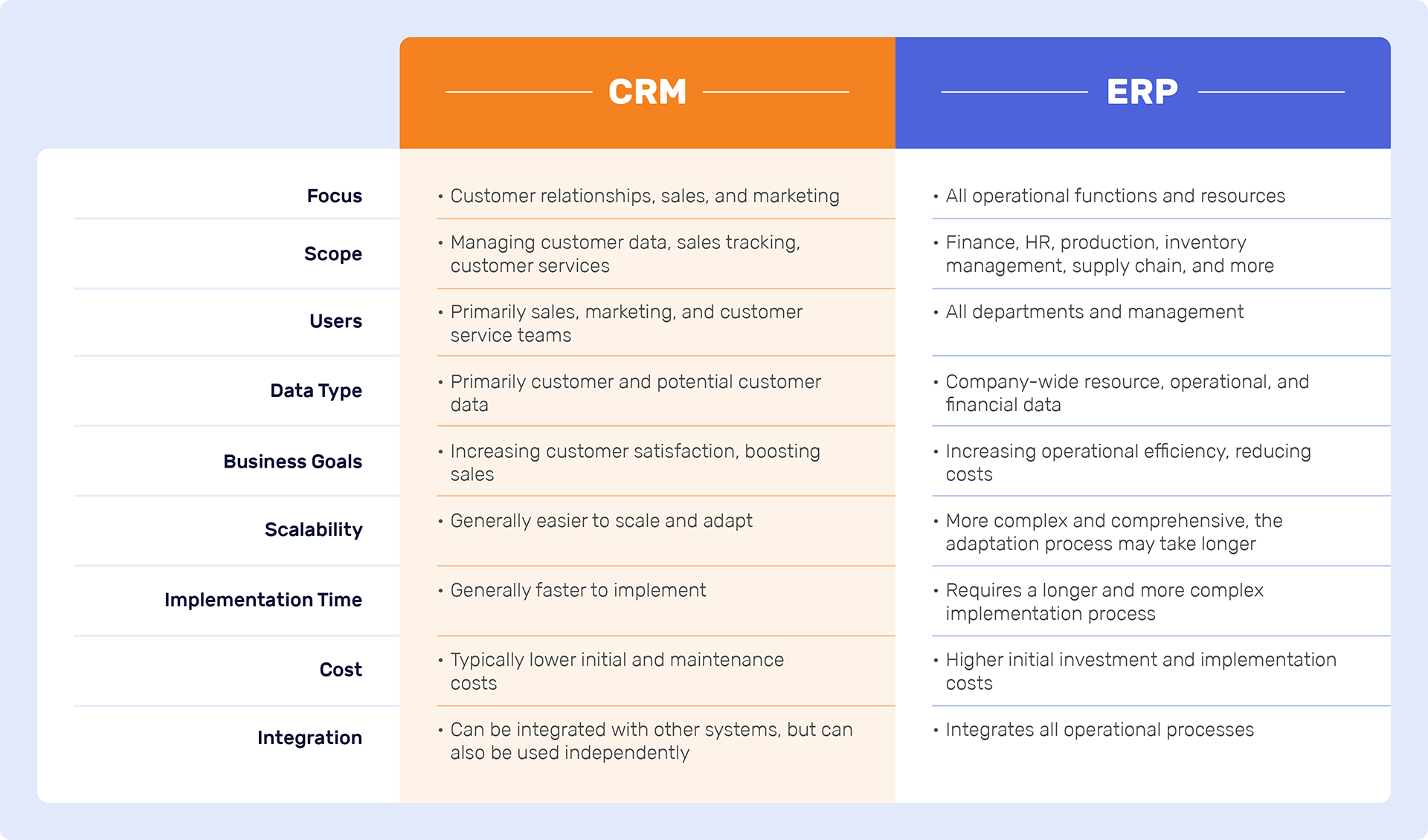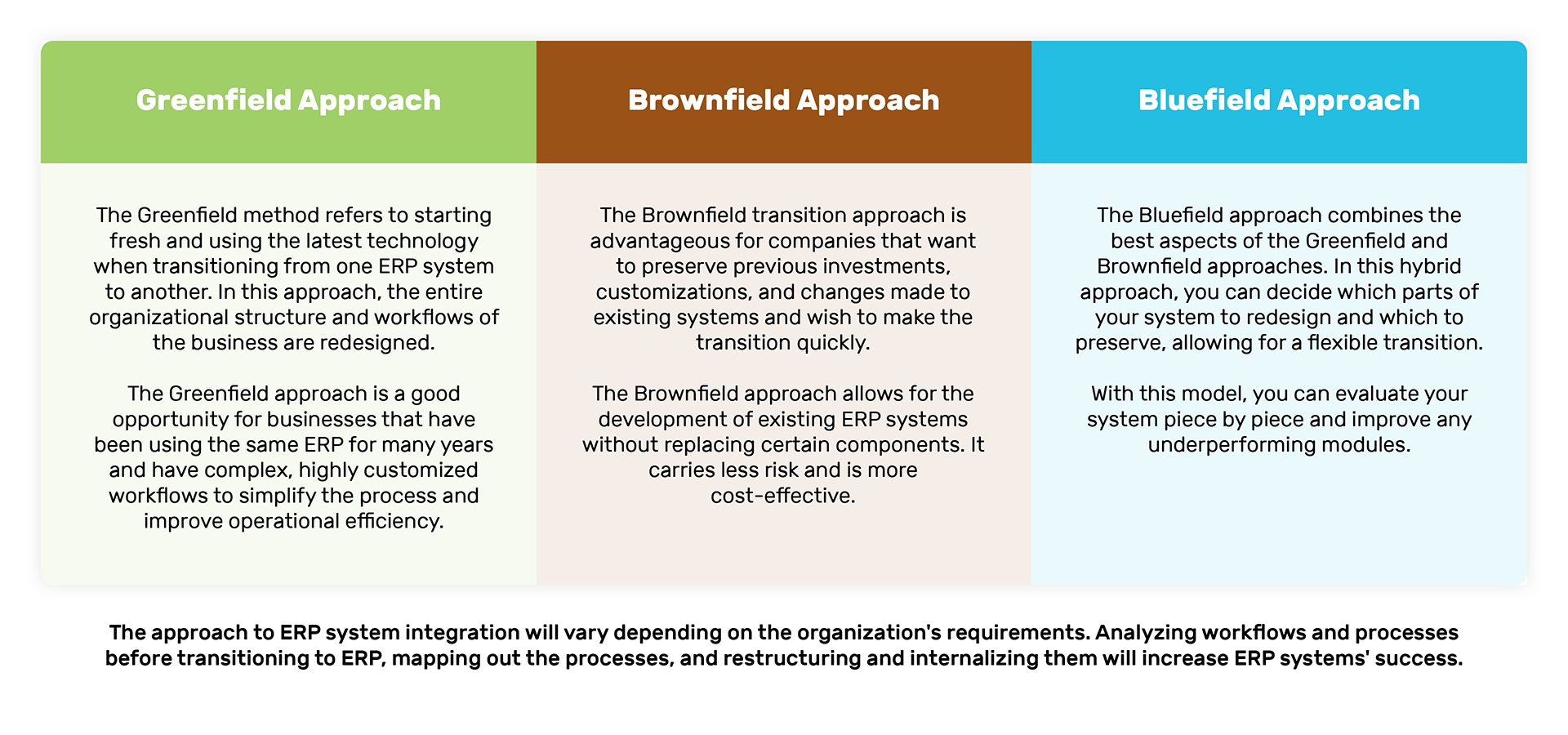
For businesses, today’s most valuable asset is data. Managing operational performance, making analytical decisions about efficiently using all types of resources, setting strategic goals aligned with the company’s vision, and determining the tactical steps to be taken are only possible when the data you produce becomes accessible and understandable.
Definition and Explanation of ERP: What is ERP?
ERP stands for “Enterprise Resource Planning” and is commonly called “Kurumsal Kaynak Planlama” in Turkish. ERP is an integrated resource planning software solution that unites a company’s departments and functions under one system.
Enterprise resource planning allows businesses to consolidate and manage their finance, human resources, production, supply chain, customer relations, and other critical business functions in a single database. Thanks to this integrated structure, businesses can use their data more efficiently, optimize business processes, and make more accurate decisions.
The Importance of Enterprise Resource Planning: What Is ERP Used For?
In today’s data-driven business world, enterprise resource planning systems (ERP systems) are necessary for all large and medium-sized businesses. These complex solutions allow companies to manage their resources more efficiently, optimize their productivity, and enhance competitiveness.
ERP is a critical management tool for modern businesses. ERP systems optimize operational processes and speed decision-making by integrating data between the company’s departments. These systems increase efficiency in many areas, from inventory management to integrated management, financial reporting, and human resources management.
Through real-time data analysis, ERP enables businesses to respond quickly to market changes, reduce costs, and increase profitability. Additionally, it standardizes business processes, reducing errors and simplifying compliance and audit processes. As a result, ERP systems increase the competitiveness of businesses, support their growth, and play a crucial role in their digital transformation journeys.
So, why is enterprise resource planning so important for business management?
We can examine the critical role of ERP systems for businesses from six perspectives:
Ensuring Data Integrity: ERP centralizes the data of all departments, preventing inconsistencies and allowing for quick access to information.
Standardization of Operational Processes: ERP increases efficiency by establishing standard workflows across the business. The added value will be even higher if ERP systems are integrated with a BPM system in this area.
Improving Decision-Making Processes: Access to real-time and accurate data enables managers to make more informed decisions.
Cost Control: ERP helps businesses use their resources more effectively, thus reducing costs.
Increasing Customer Satisfaction: With an ERP system integrated into CRM, customer demands can be met faster and more efficiently.
Legal Compliance and Reporting: ERP facilitates compliance with regulations and simplifies the creation of detailed reports.
What is an ERP System/Program?
Enterprise Resource Planning (ERP) systems are indispensable for modern businesses to manage and optimize their complex operations. ERP ensures data integrity by integrating all business departments and functions, enhancing efficiency, and making more accurate decisions.
An ERP system or program is a comprehensive software solution that integrates a business’s operations on one platform. These software solutions have a modular structure that can be customized to meet businesses' needs.
The main modules commonly used in ERP systems are:
- Finance and Accounting Management
- Human Resources Management
- Production Planning and Management
- Supply Chain Management
- Inventory Management
- Asset Management
- Business Planning and Project Management
- Security Management
ERP software integrates these modules to consolidate the business’s data into a single system.
Additional modules specific to industries, such as E-commerce Integration, Business Intelligence and Reporting, Quality Management, Asset Management, and R&D Management, allow businesses to adapt ERP systems according to their needs.
Thus, communication and data flow between departments occur seamlessly.
ERP’s Contribution to Business Processes
The contribution of ERP systems to business processes is multifaceted and profound. First, ERP eliminates data silos and enables real-time data flow between all departments. As a result, managers can make more accurate and faster decisions. For instance, real-time data from the sales department can directly impact production planning, optimizing inventory management in the process.
ERP systems automate business processes, reducing manual tasks; this decreases error rates and increases efficiency. Financial reporting processes become faster and more accurate, allowing a better understanding of the company’s financial situation.
In supply chain management, ERP systems optimize processes from demand forecasting to logistics, reducing costs and improving customer satisfaction. In human resources management, all processes, from hiring to performance evaluation, become more efficient.
Additionally, enterprise resource planning software standardizes business processes, ensuring company consistency and making adopting best practices easier. Customer relationship management consolidates all customer interactions in a central system, allowing for more personalized service delivery.
In conclusion, ERP systems increase operational efficiency, reduce costs, improve decision-making processes, and provide businesses with a competitive advantage. These benefits make ERP a strategic investment for companies.
Advantages of ERP Systems
The main advantages of enterprise resource planning programs for businesses are as follows:
Data Integration and Transparency: ERP integrates the data of all departments into a single platform, ensuring data consistency across the business. Managers can view the company’s situation in real-time and make more informed decisions.
Operational Efficiency: Automating manual processes reduces repetitive tasks and allows employees to focus on more strategic work. This increases overall efficiency and reduces business costs.
Improved Planning and Forecasting: ERP systems can analyze past data to make more accurate demand forecasts. This optimizes inventory management, improves production planning, and reduces resource waste.
Improvement in Customer Services: Integrated CRM modules centrally manage customer information, enabling more personalized service delivery and increasing customer satisfaction.
Financial Control and Reporting: ERP tracks and analyzes financial data in real time. This provides more accurate financial reports, better cash flow management, and more effective budgeting.
Legal Compliance and Risk Management: ERP systems simplify regulatory compliance and strengthen internal control mechanisms. This reduces financial risks and simplifies audit processes.
Supply Chain Optimization: ERP integrates all supply chain processes from suppliers to customers. This optimizes stock levels, shortens supply processes, and reduces logistics costs.
Collaboration and Communication: It facilitates information sharing between departments, which increases collaboration and accelerates decision-making processes.
Scalability: ERP systems can expand in parallel with the growth of the business. New modules or features can be easily added, allowing the business to adapt to future needs.
Data Analysis and Business Intelligence: Integrated analytics tools transform data into meaningful insights, providing powerful insights for trend analysis, performance measurement, and strategic planning.
Mobile Access: ERP systems can be accessed through mobile applications. This enables employees to access critical data and manage business processes outside the office.
Competitive Advantage: The combination of all these advantages makes businesses more agile, efficient, and customer-focused, which creates a competitive advantage in the market.
What Are the Differences Between CRM and ERP?
CRM (Customer Relationship Management) and ERP (Enterprise Resource Planning) systems are important software solutions to increase business efficiency. While both aim to improve business productivity, their focus areas and scopes differ.
CRM primarily focuses on customer interactions and sales processes, while ERP offers a more complex system that covers all the business’s internal processes. CRM helps manage customer data, track sales opportunities, and improve customer service, while ERP integrates all operational functions, including finance, human resources, production, supply chain, and more.

In summary, ERP is a highly comprehensive and multidimensional system that primarily aims to integrate production-focused operational functions, while CRM specifically focuses on customer relationships.
What Are the Main Differences Between BPM and ERP Systems?
BPM and ERP systems are equally critical for businesses but serve different purposes and functionalities.
Below, we’ll try to summarize the key differences between BPM and ERP systems in 9 points:
Differences in Purpose and Focus
ERP Systems: ERP systems are designed to integrate various business functions into one system. Their core focus is to automate and centralize the flow of information between different departments, such as finance, human resources, production, supply chain, and sales. ERP systems enhance overall business efficiency by ensuring smooth workflow throughout the organization.
Differences in Functional Scope
BPM Systems: BPM’s scope focuses directly on process management through workflows. BPM systems provide tools to model, automate, and optimize workflows. They are particularly used in approval processes, sequential tasks requiring tracking, or compliance management, where customization and flexibility are needed.
ERP Systems: ERP systems have a broader scope and cover multiple business functions. They come with predefined modules to manage operational areas like accounting, inventory management, procurement, and human resources. ERP is less about process management and more about managing and automating all business operations.
Differences in Flexibility and Customization Capabilities
BPM Systems: BPM systems are highly flexible and can be customized to fit unique business processes. They offer the ability to design and modify workflows as needed, making it easier for businesses to adapt to changing needs and environments.
ERP Systems: While ERP systems can also be customized, they tend to be less flexible than BPM systems. Due to their integrated nature, customizations in ERP systems generally take more time and cost more. Additionally, ERP customizations can impact system updates and maintenance.
Differences in the Implementation Approach
ERP Systems: ERP implementations are typically more complex and time-consuming, requiring comprehensive system overhauls. ERP projects often involve deploying all modules simultaneously but completing this process can lead to significant disruptions.
Differences in User Experience Management
BPM Systems: BPM platforms are designed for end users and process designers. They offer intuitive user interfaces for process modeling, task management, and workflow visualization. With drag-and-drop features, BPM systems make process design accessible, even to non-technical users. Today, many BPM systems can be easily adapted using low-code or no-code approaches.
ERP Systems: ERP interfaces are generally more complex due to their wide range of functionalities. They are designed for different departments, each with specific user needs. Expert developers and user training are required for ERP systems to be effectively adapted and used.
Differences in Data Management Focus
BPM Systems: BPM focuses on process data, such as performance metrics, task status, and workflow efficiency. It can integrate with other systems to exchange data when necessary for process execution.
ERP Systems: ERP systems are data-centric and manage large amounts of transactional data across different departments. They provide a centralized database that allows real-time data access and reporting.
Differences in Integration Capabilities
ERP Systems: ERP systems also have high integration capabilities. However, they are more focused on integrating the internal functionalities within the ERP package. Integrating ERP with external systems can be complex and require middleware or custom development (web services).
Differences in Application Areas
BPM Systems: Common use cases for BPM include process optimization, workflow automation, compliance management, and technical support process improvements. For example, a BPM system can automate the approval process for a corporate procurement transaction, increasing efficiency and reducing delays.
ERP Systems: ERP use cases are broader and cover inventory management, financial accounting, payroll processes, stock tracking, and order management. For example, an ERP system can automatically track inventory levels across different warehouses, integrate with suppliers, and generate financial reports.
Differences in Goals and Objectives
BPM Systems: BPM aims to continuously improve process efficiency, effectiveness, and agility. It also aims to achieve ideal workflows and maximize process outcomes.
ERP Systems: ERP is used to help improve operational performance by bringing together all the components of the business that enable accurate and real-time information processing, optimizing all business processes.
In summary, BPM focuses on business processes and was created to show a high level of flexibility and optimize and manage workflows. At the same time, BPM software, which has a more agile structure, can be implemented in phases and is designed to integrate much more easily with other systems.
Both systems cover complementary ends of business management. ERP manages core functions and data. On the other hand, BPM defines workflows and provides a path for continuous transformation. Additionally, as a final note, to ensure a seamless digital transformation of business systems, the integration and joint use of both systems reflect an excellent managerial vision.
Advantages and Challenges of BPM, CRM, and ERP System Integration
The integrated use of Business Process Management (BPM), Customer Relationship Management (CRM), and Enterprise Resource Planning (ERP) systems provides significant advantages for businesses. However, this integration process also brings some challenges.
Here are the advantages and disadvantages of integrating these three systems:
Advantages of BPM, CRM, and ERP System Integration
Excellent Data Management
Unified Data Source: Integration allows all systems to access the same database. This eliminates scattered data silos, ensuring consistency and accuracy. For example, changes made to customer information in CRM are reflected in ERP, ensuring accurate billing and maintaining customer trust.
Real-Time Data Access: Integrated systems allow for real-time data updates, enabling decision-makers always to access the most current information. This improves responsiveness to market changes and enhances decision-making capabilities.
High Operational Efficiency
For example, an ERP system integrated with CRM can automatically synchronize customer orders with product stock levels and fulfillment processes, saving time and reducing errors.
End-to-End Process Automation: Integrating BPM, ERP, and CRM allows for the automation of complex workflows spanning multiple departments.
For example, a BPM system can manage the customer onboarding process, while CRM handles sales tracking and ERP automates contract management.
Better Customer Experience
Comprehensive Customer View: Integrating CRM with ERP and BPM enables a 360-degree view of the customer. Marketing, sales, service, and support teams can access detailed historical information about the customer’s brand experience, preferences, and interactions, providing more personalized and effective service.
Faster Response Times: Integration reduces the time to access information and complete tasks. For instance, customer service representatives can quickly review customer behavior, inventory availability, and past interactions through a single interface, allowing for faster issue resolution.
High Agility and Flexibility
Cost Optimization
Reduced Operational Costs: Automation and improved processes reduce the need for manual intervention, minimize errors, and increase process efficiency, thus lowering operational costs.
Lower IT Maintenance Costs: An integrated solution reduces the complexity of maintaining independent systems, reducing overall IT overhead and maintenance costs.
Advanced Compliance and In-Depth Analyses
Capabilities: By combining data from CRM, ERP, and BPM, more insightful and comprehensive reports can be produced for strategic planning and compliance audits.
Challenges and Considerations for BPM, CRM, and ERP System Integration
First, implementing and integrating all systems as a cohesive whole is a challenging process. This comprehensive adaptation is difficult due to the high initial setup costs on the one hand and the long time required for this process on the other.
Integrating BPM, CRM, and ERP systems can be costly due to the need for custom software development, hardware, and consulting services. These systems generally require significant investments to customize and configure in various ways. Moreover, integration projects can take several months or even years, depending on the size and complexity of the organization. This can temporarily disrupt business operations.
Moreover, maintaining compliance with data protection regulations (such as GDPR) becomes more complex when data flows between multiple systems. Organizations must ensure that their integrated systems meet all necessary compliance standards.
Some potential challenges also stem from users’ resistance to change and their need for proper training to adapt to the new system. Considering that employees are accustomed to the old systems they have been using, it is understandable that they may resist adopting new systems. This resistance can reduce workforce efficiency and motivation. Therefore, managing this transition in a planned and foresightful manner is crucial. Providing users with comprehensive training programs on the new applications is another important area that requires attention.
Integrated systems require regular updates and maintenance to ensure compliance and performance. This should be treated as a serious operational cost, as maintenance, updates, and support services often require specialized expertise.
Another issue is the complexity of working with multiple vendors for different components (ERP, CRM, BPM), which can complicate support and maintenance processes. It is essential to ensure that updates and changes from one vendor do not disrupt the overall integration.
Working with an integrated system composition can create a risk of overreliance on that system. For example, when systems are tightly integrated, a malfunction in one component can disrupt the entire operation. If the ERP system goes down, it can also affect CRM and BPM functions. Additionally, relying on a single vendor for an integrated solution can limit flexibility and weaken your negotiating power when considering system upgrades.
Performance issues may arise as data volume and the number of users increase in such integrated systems. Ensuring that the infrastructure can handle the increased load without compromising performance is important. While integration can improve efficiency, it can also limit the customization capabilities of independent systems. This can make it difficult to develop/customize solutions to meet the “special” needs of certain departments that may not align with the integrated system.
Ultimately, integrating BPM, CRM, and ERP systems gives businesses advantages like increased operational efficiency, improved data accuracy, and enhanced customer experiences. However, the complexity of such integration, along with the costs and potential risks that need careful management, should also be considered.
To achieve a successful and efficient outcome, comprehensive planning, regular maintenance, and user training should always be key items on your agenda. This will enable businesses to become more agile, efficient, and customer-focused, gaining a competitive edge in the market.
How Can Businesses Transition to ERP?
Enterprise resource planning is critical in a business’s digital transformation journey. ERP systems help businesses make data-driven decisions and maintain their competitive edge in the Industry 4.0 era. For this reason, businesses should prioritize ERP investments strategically and continuously keep their systems current.
When businesses select ERP solutions that fit their needs and industries, they should consider the system’s scalability, user-friendliness, and compatibility with existing business processes. A well-chosen and well-implemented ERP system will significantly contribute to the company’s long-term growth and success.
Additionally, ERP systems are expected to become even more powerful with technologies such as artificial intelligence and machine learning. These advancements will enhance ERP’s forecasting capabilities and enable businesses to make more proactive decisions.
There are several models that businesses can use in ERP system integration.

What Are the Future Predictions for ERP Systems?
With technology advancing so rapidly, it is difficult to predict how ERP (Enterprise Resource Planning) systems will evolve in the future. However, these systems will continue transforming as technology and business needs change. Considering current technological advancements, it’s not hard to foresee developments in the areas I’ll share below.
When we talk about the future and technology, the first thing that comes to mind is probably Artificial Intelligence (AI) and Machine Learning in ERP systems. By integrating AI and machine learning into ERP systems, it will be possible to analyze data more intelligently and gain meaningful insights. This will make it easier for businesses to conduct predictive analytics and make strategic decisions.
AI-supported automation tools will replace routine and repetitive tasks, speeding up business processes and reducing errors. For example, applications like automatic stock replenishment based on customer demands in inventory management will become widespread.
Cloud-based ERP solutions will allow businesses to easily keep up with their growth rates. With faster implementation, lower initial costs, and easier accessibility, cloud-based systems will provide more flexibility and scalability to businesses, making them more prevalent in the future. Also, with the increasing remote work trend, cloud-based ERP systems will be preferred to enable businesses to operate from anywhere and on any device.
In today’s software world, the most significant risk we face is increased cyber threats. This will require strengthening the security measures applied in ERP systems. In the near future, ERP solutions will be equipped with advanced encryption, multi-factor authentication, and threat detection systems. Regulations like GDPR will require ERP systems to take stricter measures to ensure compliance with data privacy, promoting the use of more audit and reporting tools to protect user data security and privacy.
ERP systems will become more powerful with big data analytics. Big data analytics will process large volumes of data, providing deeper insights into customer behavior, market trends, and operational efficiency. Future ERP systems will offer customizable reporting and analysis tools based on user needs, providing more meaningful data for different departments and managers.
Additionally, when IoT data is integrated into ERP systems, problems with machinery or signs of wear can be automatically detected. This will make maintenance processes more proactive, reducing downtime and costs.
Improvements in user experience and interface design will reduce the complexity of ERP systems and make them more user-friendly. In the future, ERP solutions will be designed to be more intuitive, visual, and mobile-friendly to ensure ease of use. Enhancing user experience will increase system adoption and efficiency. We can already foresee that voice commands and chatbots will be widely used in ERP systems in the future. This will allow users to create reports, enter data, and interact with the system through simple commands.
This will allow businesses to integrate different solutions according to their needs seamlessly. ERP systems will align with digital transformation strategies, integrating smart factories and Industry 4.0 technologies. This will promote the automation of production processes, process optimization through data analytics, and greater transparency in supply chain management.
Production data will be instantly transferred to the ERP system, enabling managers to monitor performance in real time and make informed decisions.
ERP systems will become more modular in the future, consisting of components that can be customized to meet businesses’ needs. Companies can reduce costs and simplify the system by selecting and integrating only the necessary modules. APIs and microservices architecture will make integrating ERP systems with other business applications and software easier.
This will allow businesses to integrate different solutions according to their needs seamlessly. ERP systems will align with digital transformation strategies, integrating smart factories and Industry 4.0 technologies.
This will promote the automation of production processes, process optimization through data analytics, and greater transparency in supply chain management. Production data will be instantly transferred to the ERP system, enabling managers to monitor performance on the production line in real time and make decisions.
In conclusion, technological innovations and business needs will shape the future of ERP systems. Developments in cloud technologies, artificial intelligence, IoT, big data, and security measures will make ERP solutions more flexible, powerful, and user-friendly.
These developments will allow businesses to gain a competitive edge, increase operational efficiency, and provide better customer experiences. It will be critical for businesses to closely follow these trends and update their ERP systems accordingly to remain successful and sustainable in the future.

